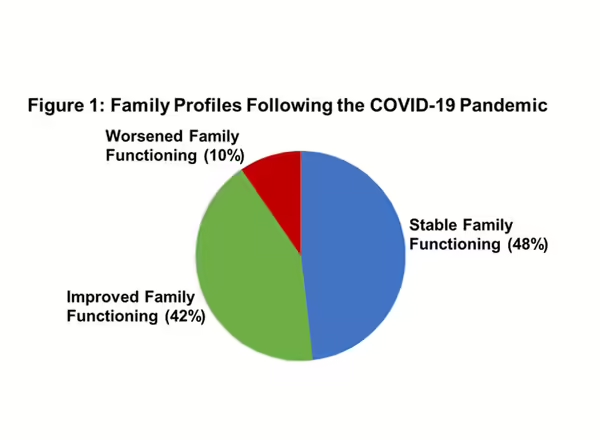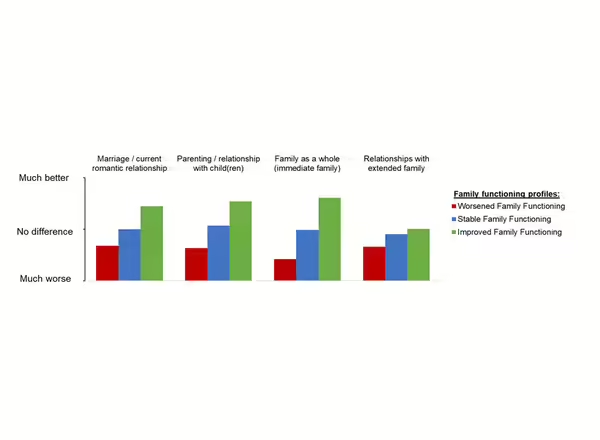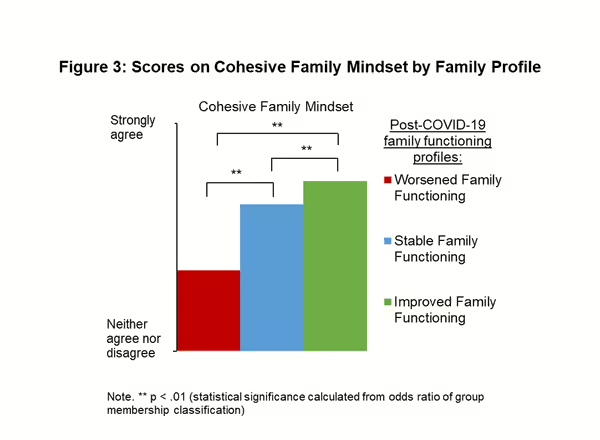
Family Resiliency During COVID
The COVID-19 pandemic was a challenging time in the lives of many individuals and families. But were its effects negative for all families or did some families maintain their level of well-being, or even experience improvements in it, as a result of the COVID-19 pandemic? A recent study led by Extension Specialist Allen Barton sought to answer this question.
In September of 2022, approximately two and half years after the onset of the pandemic, a nationwide sample of nearly 600 adults living in the United States were surveyed. Individuals were asked how aspects of their family life had changed as a result of the pandemic. Individuals answered this question with respect to changes in their marriage (or current romantic relationship), in their relationship with their child(ren), in their immediate family as a whole (those they live with), and in their relationships with extended family.

Three distinct groups of families were identified based on individuals’ responses to these four questions. As Figure 1 shows, we found three distinct family profiles, which were classified as
- worsened family functioning (10% of sample),
- stable family functioning (48% of sample), and
- improved family functioning (42% of sample).
As shown in Figure 2, individuals in the worsened family functioning reported the lowest levels on these COVID-related questions, with average response levels indicative of being “somewhat worse” on all four questions.

In contrast, individuals in the stable family functioning group had average response levels on each of the four questions indicative of “no difference/remained the same.” Individuals in the improved family functioning group had average response values that indicated “somewhat better” change as a result of the COVID pandemic for marriage, parenting, and immediate family relationships; responses for relationships with extended family remained at the midpoint on this scale (i.e., no difference/remained the same) for this group.
These results highlight that a substantial number of individuals reported that they did, in fact, experience improved family relationships – at least within the immediate family – as a result of the COVID-19 pandemic.
Why is it that some families improved and some declined during trying times? The second aim of our study sought to help answer such a question by identifying factors that differentiated the three family profiles identified in Figure 1.
For this, we investigated group differences across a set of 11 different variables hypothesized to influence the degree to which stressors affect family relationships. Those variables were:
- Couple Communication
- Couple Social Integration
- Partner Gratitude
- Cohesive Family Mindset
- Perceived Stress
- Financial Hardship
- Loneliness
- Income
- Education
- Marital status
- Gender
All measures had been utilized in prior research, with the exception of one measure we developed for the current study that assessed what we called a Cohesive Family Mindset. Multiple resilience researchers have described how resilient families often possess higher-level meanings, or schemas, of what it means to be a family. Such mindsets provide family members with an orientation to family life that transcends the individual and supersedes each family member’s immediate desires and preferences. It’s getting at “us” and what is required to make the family one desires a reality.

For our measure, the four items we used to assess Cohesive Family Mindset were:
- Our family has a strong sense of being a team
- As a family, we are on the same page with a lot of things
- It makes me happy to make other people in my family happy
- My family is worth the investment and sacrifice it requires
Returning to our second question – how were individuals in these family profiles different across these 11 variables? Somewhat to our surprise, only one variable significantly differentiated all three groups. That variable? Our newly developed measure of cohesive family mindset. As Figure 3 illustrates, individuals in the improved family functioning group following the pandemic reported a higher score on this construct compared to individuals in the stable and worsened family functioning profiles (i.e., had the most amount of agreement with the Cohesive Family Mindset items).
Additionally, individuals in the worsened family functioning profile reported a lower score on this measure compared to individuals in the other two family profiles (i.e., had the least amount of agreement with the Cohesive Family Mindset items).
What is our main takeaway from this second set of findings?
For that, let’s consider the earlier writing by Dr. Scott Stanley, one of the study authors, from 2009:
As a field, I think social science has missed something when it comes to measuring things that are important about families. Marital happiness is, to be sure, important (but) there is a different, maybe deeper, kind of happiness that some people experience in life…like a contentment that a couple can experience (but might not experience) from building a family together.
During times of adversity and hardship, orientations to family life that emphasize teamwork and personal fulfillment through meeting the needs and wants of the broader family unit—versus fulfillment through meeting the needs and wants of oneself—may provide a unique strength-based asset for families. In this way, as an individual adopts a more cohesive family mindset, personal desires find alignment (and not opposition) to familial investments.
Theoretically, we believe that a cohesive family mindset creates a home in which the sacrifices necessary for the good of the family are not a barrier to one’s happiness but rather another means by which happiness can be realized. And in doing so, family relationships can grow stronger, even in the midst of a pandemic.